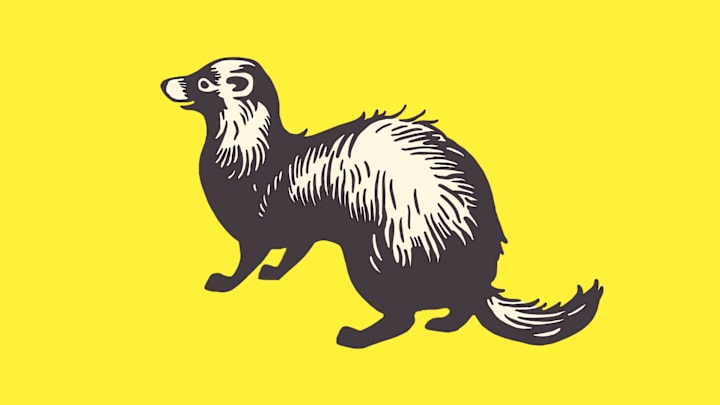“Pop! Goes the Weasel” is one of the most pervasive kids’ songs ever written: The earworm pops up everywhere from jack-in-the-box toys to Data and Riker’s first encounter in Star Trek: The Next Generation. But not only did the tune likely not start out as a nursery rhyme, the lyrics might not even be about a weasel popping out from a hole in the ground.
Make a Song and Dance About It
People have been getting “Pop! Goes the Weasel” stuck in their heads since the early 1850s. Although the exact origin of the song isn’t known, it became a craze in England at the end of 1852, with an ad in The Birmingham Journal promoting dance lessons for the “highly fashionable” song that was “recently introduced at her Majesty’s and the Nobility’s private soirees.” Essentially, “Pop! Goes the Weasel” was the Victorian era version of Los del Río’s “Macarena,” with the song and dance partly taking off thanks to its association with Queen Victoria.
It wasn’t long before the ditty reached American ears, with the song’s sheet music being published in the United States in 1853. That same year, dance teacher Eugene Coulon described it [PDF] as “an old and a very animated English Dance that has lately been revived among the higher classes of society.” He says that it takes the form of a “Country dance,” with “Ladies and Gentlemen being placed in lines opposite to each other.” At this point in the song’s history, the only lyrics were “pop goes the weasel,” which was sung when dancers passed under the arms of others.
By October 1854, a song about the song had even been published, with the lyrics speaking of its overwhelming popularity: “Go where you will, you’ll hear it still, all dance Pop goes the Weasel.” Although the original tune only featured one line of lyrics, people soon started writing their own words. In November 1855, it was reported that “almost every species of ribaldry and low wit has been rendered into rhyme to suit it,” but what exactly those rhymes were is unknown. Some of the earliest surviving lyrics come from Charley Twiggs in America, who in 1856 wrote verses such as:
“Queen Victoria’s very sick,
Napoleon’s got the measels,
Sebastopol is won at last,
‘Pop goes the Weasel.’
All around the Cobblers house,
The Monkey chased the people,
The Minister kiss’d the Deacons wife,
Pop goes the Weasel.”
The second verse has echoes of the version now most commonly sung in the U.S. these days. It wasn’t until 1917 that mulberry bush started to replace cobblers house and that the monkey chased a weasel, rather than people. The earliest version sung in 1850s England had almost entirely different lyrics (aside from the final line):
“Up and down the City-road,
In and out the Eagle,
That’s the way the money goes,
Pop goes the weasel.”
This is now the second verse that is commonly sung in the UK today, with the modern first verse popping up in print by 1905:
“Half a pound of tuppenny rice,
Half a pound of treacle.
Mix it up and make it nice,
Pop goes the weasel.”
Weasels and Spinners and Slang, Oh My!
There has been a lot of speculation about what the lyrics of “Pop! Goes the Weasel” might really mean—here are the most popular theories, including mustelid movements, a yarn measuring tool, and Cockney rhyming slang.
Back in 1856—when the tune still had listeners in its grip—an unnamed writer in Harper’s New Monthly Magazine stated the line was the result of mishearing. They believed it originated with Methodist preacher James Craven, who during a sermon in Virginia said, “Take a kernel of that wheat between your thumb and finger, hold it up, squeeze it, and—pop goes the weevil.”
Perhaps the easiest explanation is that the lyrics are literally about a weasel popping out of a hole. This theory is linked to the dance that accompanied the song, with J. Holden MacMichael writing in an 1905 edition of Notes and Queries that “The weasel is doubtless the dancer, as he or she ‘pops’ through or under the arms of the others in the same sinuous manner as a weasel enters a hole, for it was at this part of the dance that all present used to sing ‘Pop goes the weasel.’”
Another theory is that weasel is not referring to the animal, but to a spinner’s weasel. Yarn spun on a spinning wheel could be measured on a weasel, which featured a mechanism that would make a popping sound when the desired length had been reached. This interpretation may have been the inspiration for the textile version of the verse:
“A penny for a ball of thread,
A farthing for a needle,
That’s the way the money goes,
‘Pop goes the weasel.’”
The words of the UK version of the rhyme are partly related to London. The Eagle is an old pub—which is still serving pints to this day—just off City Road. The final line is usually attributed to 19th-century slang: pop shop referred to pawnbrokers, so to pop something was to pawn it. There’s less certainty about what weasel means. One suggestion is that it’s a coat, which comes from the Cockney rhyme slang weasel and stoat, but Gary Martin at Phrase Finder disputes this because that phrase wasn’t used until the 1930s. Other suggestions include a purse, silverware, and a tailor’s iron.
The lyrics’ meaning may forever remain a mystery. And it doesn’t matter which version of the song you sing, or if you even truly understand what the words are referencing—the tune is likely to get stuck in your head no matter what.
Read More About Nursery Rhymes:
